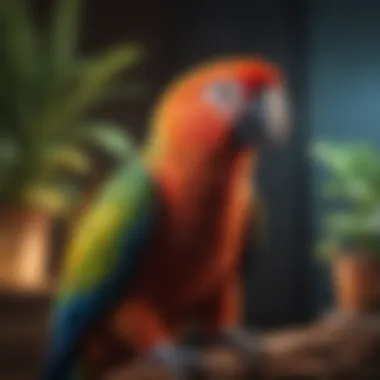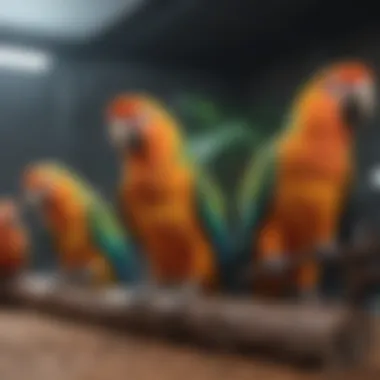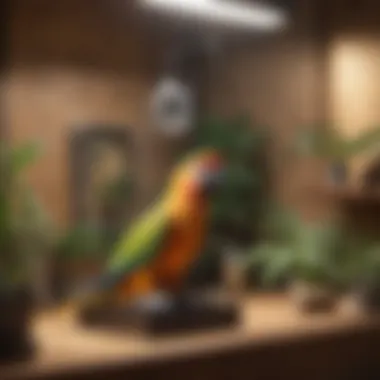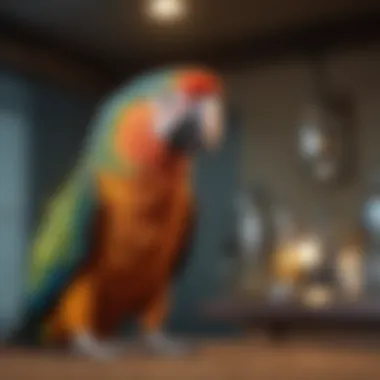Understanding the Vital Role of UV Lamps for Parrots


Intro
UV lamps play a crucial role in the care of parrots. These lamps can affect everything from health to behavior. Parrots, like other birds, require specific wavelengths of light, particularly in the UV spectrum, which is often missing in standard home lighting. Understanding how UV lamps benefit these intelligent creatures is essential for proper pet ownership.
Understanding Your Pet
Understanding parrots involves knowing their needs and behaviors. They are not only beautiful but also complex animals deserving of thoughtful care.
Pet Behavior Basics
Parrots are naturally social, often forming close bonds with their companions. They thrive on interaction and can exhibit signs of stress or boredom when left alone for extended periods. Observing their behavior can also offer insights into their emotional state.
Common Breed Characteristics
Different parrot species display varying traits. For example, African Grey parrots are known for their incredible intelligence and vocalizations. In contrast, Budgerigars are generally more playful and less demanding in terms of mental stimulation. Knowing these characteristics aids owners in providing tailored care.
Species-Specific Needs
Each species has unique requirements regarding UV exposure. Larger parrots, such as Macaws and Cockatoos, may need more UV light than smaller breeds. Tailoring UV lamp usage to specific species maximizes health benefits and enhances well-being.
Health and Wellness
Regular health assessments are vital for parrots. Routine vet check-ups can help identify potential health issues before they escalate.
Routine Vet Check-ups
Schedule annual visits to avian veterinarians. These professionals specialize in bird health and can offer targeted advice on UV lamp usage and overall care.
Vaccination Needs
Vaccinations protect parrots from common avian diseases. Check with your veterinarian about appropriate vaccines based on your parrot’s environment and lifestyle.
Recognizing Signs of Illness
Monitor your parrot for changes in behavior, appetite, or appearance. Quick identification of issues can lead to timely treatment, improving the outcome for the bird. Pay special attention to any respiratory changes or abnormal droppings.
Enrichment and Activities
Enrichment is essential for a parrot's physical and mental health. Activities can range from interactive toys to socialization with humans or other pets.
Indoor vs.
Outdoor Activities
Both indoor and outdoor activities have benefits. Indoor play can involve climbing structures and puzzle toys, while outdoor sessions allow for natural sunlight exposure. However, be cautious about weather and predators when outdoors.
Interactive Toys and Games
Toys that encourage problem-solving can help keep your parrot engaged. Rotate toys regularly to maintain interest and challenge them mentally. Consider items that encourage foraging as well, as foraging abilities are natural to parrots.
Socialization Opportunities
Social interaction is vital. Introduce your parrot to family members or trusted friends to help them build confidence around others. Gentle and consistent interaction promotes positive behavior.
Finale


In summary, understanding the importance of UV lamps can significantly enhance the lives of parrots. Not only do these lamps support biological functions, but they also contribute to overall behavior and well-being. Tailoring specific needs and practices ensures a better quality of life for these fascinating companions. As a parrot owner, your commitment to their health can foster longer, happier lives.
Foreword to UV Light and Parrots
Understanding the role of UV light in the lives of parrots is crucial for their health and wellbeing. Parrots, like many avian species, depend on specific wavelengths of light for proper biological functions. This section will explore the significance of UV light and its implications for the care of these vibrant birds.
Significance of UV Light for Avian Species
Avian species, including parrots, require ultraviolet (UV) light for several critical biological processes. One of the primary needs is the synthesis of Vitamin D. This vitamin is essential for calcium absorption, which affects muscle function, bone health, and overall vitality.
Research indicates that without proper exposure to UV light, parrots can suffer from nutritional deficiencies. These deficiencies can lead to serious health problems, including metabolic bone disease.
Beyond the physical aspects, UV light also plays a role in behavioral health. Parrots exposed to appropriate UV wavelengths tend to exhibit natural behaviors such as foraging and social interaction. This emphasizes the importance of UV light in maintaining not only the physical health of parrots but also their mental wellbeing.
Understanding Natural Sunlight Exposure
Natural sunlight provides a balance of different light wavelengths, including UVA and UVB rays. In the wild, parrots engage in activities that naturally expose them to sunlight. This exposure is vital for regulating their circadian rhythms, which affects sleep cycles and feeding behaviors.
Many pet owners may underestimate the amount of sun exposure their parrots need. Even in an indoor environment, replicating sunlight is necessary. Sprinkling UV lamps in areas where parrots spend time helps mimic the natural conditions found outdoors. Parrots thrive when they can receive adequate UV light exposure, and such arrangements offer the opportunity to promote their health and happiness.
By gaining a deep understanding of these factors, parrot owners can make informed decisions about how to care for their pets, ensuring they receive the UV light exposure needed for a fulfilling and healthy life.
Biological Needs of Parrots
Understanding the biological needs of parrots is central to their care and overall wellbeing. A lack of essential environmental factors can lead to health issues and behavioral problems. Among these needs, UV light plays a significant role influencing both physical health and mental welfare.
Vitamin Synthesis
Vitamin D synthesis is crucial for many animals, and for parrots, it occurs through exposure to natural UVB light. This vitamin enables calcium absorption, which is pivotal for bone health. Inadequate vitamin D could lead to conditions like metabolic bone disease, a common ailment in captive avian species.
In the wild, parrots bask in the sun, absorbing UVB rays. However, indoor environments often lack these necessary wavelengths. Replacing natural sunlight with UV lamps that emit suitable UVB radiation can help mimic their biological needs. When selecting a UV lamp, make sure it produces UVB light in the correct wavelengths between 290-320 nanometers.
- Key Points:
- Essential for calcium absorption
- Prevents metabolic bone disease
- Mimics natural sunlight for indoor environments
Behavioral Effects of UV Light
The behavioral effects of UV light on parrots cannot be underestimated. Studies have shown that UV exposure can influence a bird's mood and activity levels. When parrots are exposed to UV light, they tend to exhibit more vibrant behaviors. They become more exploratory, vocal, and interactive. This increased engagement is linked to their instinctual response to environmental stimuli.
A lack of UV light often leads to lethargy or even stress. Birds confined to dimly lit areas may express frustration or boredom, which can result in feather plucking or other behavioral issues. It is essential to ensure that parrots have access to appropriate UV lighting to facilitate a stimulating environment.
- Benefits of Proper UV Exposure:
- Enhances overall activity
- Lowers stress levels
- Promotes natural behaviors
Types of UV Lamps for Parrots
Understanding the various types of UV lamps is essential for ensuring the optimal health and wellbeing of parrots. These lamps are specifically designed to provide the necessary UV light that parrots typically receive from natural sunlight. Different types of lamps offer unique characteristics and benefits, which should be considered when selecting the right option for your pet.
Full-Spectrum UV Lamps
Full-spectrum UV lamps are engineered to closely mimic natural sunlight. These lamps emit both UVA and UVB rays, providing a comprehensive array of wavelengths that are vital for avian health. Parrots require UVB light for vitamin D synthesis, which is essential for calcium absorption. By utilizing full-spectrum lamps, owners can create a safe, controlled environment that supports their parrot's biological needs.
Full-spectrum lamps often come in various forms, including fluorescent tubes and compact bulbs. Choosing a full-spectrum lamp ensures that parrots can bask in the benefits similar to those in their natural habitats.
UVB and UVA Lighting Explained


Understanding the distinction between UVA and UVB lighting is crucial for effectively using UV lamps. UVA rays are less harmful than UVB rays and are primarily responsible for stimulating natural behaviors in parrots, including mating and foraging. In contrast, UVB rays play a fundamental role in facilitating vitamin D production, which is directly linked to proper bone and feather health.
Parrot owners should ensure that their chosen UV lamp emits adequate levels of both UVA and UVB light. Failure to provide both types may result in behavioral problems and health issues. Be aware that not all lamps labeled as
Benefits of Using UV Lamps for Parrots
Using UV lamps for parrots provides several significant advantages that enhance both their physical and psychological wellbeing. Given that these birds are naturally exposed to sunlight in the wild, simulating such exposure at home is crucial. The specific benefits include enhanced physical health, improved mental wellbeing, and engaging behavioral enrichment. These elements collectively lead to a happier and more vibrant parrot.
Enhanced Physical Health
UV lamps contribute immensely to a parrot's physical health. One of the primary roles of these lamps is to aid in the synthesis of Vitamin D. This essential vitamin is crucial for calcium absorption and bone health. Without adequate Vitamin D, parrots can develop serious health issues, including metabolic bone disease. Utilizing the right UV lamps when parrot’s indoor is key to ensuring they receive sufficient doses of UVB light.
It is essential to choose lamps that emit the correct wavelengths that are beneficial for avian species. Ideally, a full-spectrum UV lamp should be incorporated into their habitat to mimic natural sunlight as closely as possible. Birds kept in environments lacking natural sunlight are less active and might show various health problems. Regular access to UVB light encourages proper feather development and overall vitality.
Improved Mental Wellbeing
Mental wellbeing is as important as physical health. Parrots are highly intelligent animals that require mental stimulation to thrive. UV lamps play a role in this mental enrichment by simulating a day-night cycle, which can positively affect a parrot's mood and activities. When parrots receive adequate UV light, they tend to exhibit more natural behaviors.
Conversely, a lack of sufficient sunlight exposure can lead to stress and depression in parrots. The role of UV light becomes evident when observing changes in behavior; more light typically encourages parrots to be vocal, playful, and social. This increase in activity can significantly contribute to their overall happiness and prevent behavioral issues that arise from boredom or confinement.
Behavioral Enrichment
Behavioral enrichment is a critical aspect of a parrot’s life. UV lamps help to fulfill this need by closely replicating natural environments. When parrots feel secure and stimulated, they exhibit a wider range of behaviors and are less likely to engage in destructive habits. Incorporating UV lamps encourages exploration and interaction with their environment, which is vital in preventing common issues like feather plucking or excessive squawking.
It is crucial for parrot owners to ensure their birds are not just physically healthy but also mentally stimulated. Parrots need to feel engaged, and lighting can have a profound effect on their interest levels. The benefits of using UV lamps extend beyond mere health; they pave the way for a fulfilling, enriched life for these intelligent creatures.
Regular exposure to UV light can lead to greater overall satisfaction for your parrot, enhancing both physical health and emotional well-being.
Overall, the importance of UV lamps cannot be overstated. They offer various health benefits, psychological enhancements, and significant improvements in behavior, fostering a thriving environment for parrots.
Setting Up UV Lamps in Your Home
Setting up UV lamps in your home is crucial to providing proper care for your parrot. Proper installation ensures that your bird receives the necessary light exposure to promote health and well-being. Understanding how to effectively set up these lamps will maximize their benefits, while also minimizing potential risks. Here are key considerations for a successful setup.
Choosing the Right Location
The location of the UV lamp is a fundamental factor in ensuring your parrot gets adequate exposure. UV lamps should mimic the natural sunlight that parrots would receive in the wild. Choose a spot where the light can reach the parrot's cage fully. For example, avoid shadows cast by furniture or other objects that can limit exposure.
Consider placing the lamp above or to the side of the cage, but not directly above, as this can cause uncomfortable heat. Proper placement also allows the parrot to move in and out of light exposure as desired. Remember, parrots can better regulate their UV intake when they have the freedom to choose where they want to sit.
Duration and Frequency of Exposure
Understanding the duration and frequency of UV light exposure is key. Most parrots benefit from approximately 2 to 4 hours of direct UV exposure daily. This time frame can be adjusted based on your bird's specific needs and overall health. Keep in mind that older birds or those recovering from health issues may require different exposure times.
It is crucial to allow breaks during the UV exposure period. Too much light can lead to overexposure consequences. Interact with your parrot during these times to make the experience enjoyable. Set a consistent schedule that your parrot can adapt to easily. This routine can help establish a sense of security and comfort in your feathered friend’s daily life.
Monitoring Light Intensity
Monitoring the intensity of light is also essential in your setup. You should choose a lamp with an appropriate UV output for your parrot's species. Research is vital here; different types of parrots have varying needs regarding UV light intensity. For example, small species might require lower intensities than larger ones.
Some UV lamps come with integrated sensors to help you gauge light levels effectively. Using a light meter can enhance your ability to ensure proper intensity. Make sure to replace bulbs according to the manufacturer’s recommendations. Over time, bulbs lose their effectiveness in producing UV light, even though they may still emit visible light. Keep an eye on both light output and any changes in your parrot’s behavior, as shifts may indicate the need for a change in equipment.
By carefully selecting the location, duration, frequency, and intensity of UV exposure, you provide your parrot with a safe and enriching environment that closely aligns with their natural habitat.
Taking these steps seriously can lead to improved health and behavior for your parrot. The delicacies of setting up UV lamps demand attention from all pet owners who wish to ensure a thriving environment for their beloved birds.


Potential Risks of UV Light Exposure
In the discussion of UV lamps for parrots, it is essential to acknowledge that while exposure to beneficial UV light is crucial for their health, there are potential risks associated with improper or excessive use of these lamps. Understanding these risks is important not only for the well-being of the birds but also for fostering responsible pet ownership. Parrots, like any living creatures, can face challenges when their environment is altered.
Overexposure Isn’t Beneficial
Overexposure to UV light can lead to negative health impacts on parrots. Just as humans can suffer from skin damage due to too much sun exposure, birds have their vulnerabilities related to UV radiation. Symptoms associated with excessive UV exposure can include:
- Skin irritation or burns
- Eye damage, which may lead to cataracts over time
- Stress due to discomfort from excessive brightness
It is vital to regulate the duration and intensity of UV exposure for birds. Many owners mistakenly believe that more exposure is always better. However, scientific evidence suggests that moderation is key. Ensuring that your parrot receives adequate but controlled UV light will promote its health without risking harm.
Choosing Quality Products
Another significant risk lies in the quality of the UV lamps used. Not all UV lamps are created equal. Low-quality products may not emit the proper wavelengths needed for parrot health. When selecting a UV lamp, consider the following aspects:
- Certification: Ensure that the lamp meets industry standards for safety and efficacy.
- Wavelength Output: The UVB range is crucial for vitamin D synthesis; thus, a lamp that delivers this type effectively is essential.
- Warranty and Customer Support: Quality brands typically provide warranty services and customer support, an important factor if issues arise.
In summary, while UV lamps can offer numerous benefits to parrots, there are risks that owners must navigate carefully. Understanding the potential for overexposure and ensuring the selection of high-quality products will help mitigate these risks.
Proper management of UV exposure and product quality significantly enhances the health and longevity of your parrot.
How to Choose the Right UV Lamp for Your Parrot
Choosing the right UV lamp for your parrot is crucial for its health and happiness. The right lamp can mimic natural sunlight, providing essential UVB and UVA light that supports various biological functions. This section will explain important elements to consider when selecting a lamp and highlight how each choice can benefit your parrot.
Assessing Your Parrot's Needs
Every parrot species has different requirements when it comes to UV exposure. Understanding these needs can guide you in making an informed choice. Consider the following aspects:
- Species-specific Requirements: Larger parrots, such as macaws, may need more intense UV light compared to smaller birds like budgerigars.
- Age and Health Condition: Younger, healthier parrots generally have greater UV needs. Also, any underlying health issues may require special attention to light exposure.
- Living Environment: If your parrot lives indoors, it will not have access to the natural sunlight that outdoor birds enjoy, which makes artificial UV light essential.
Obtaining the proper UV lamp, tailored to your parrot’s specific needs, can profoundly impact its overall wellbeing.
Product Reviews and Recommendations
When looking to purchase a UV lamp, knowing what’s available can save time and ensure you make a wise investment. Below are some well-reviewed products:
- Zoo Med ReptiSun 10.0: A highly recommended choice for its UVB output, ideal for many parrot species.
- Light Your Birds Full Spectrum Tube: Known for covering both UVB and UVA, making it an excellent choice for avian habitats.
- Exo Terra Repti Glo 2.0: Offers low heat emissions and is perfect for smaller setups, reducing the risk of overheating.
It’s important to read through product reviews and recommendations on trusted platforms like Reddit or Facebook. Users often provide insights that can help in deciding the right lamp for your needs.
"UV exposure is not just a luxury but a vital part of a parrot's life. Careful selection of the right lamp ensures long-term health benefits."
Selecting a suitable UV lamp requires careful thought. Consider your parrot's specific needs and thoroughly research available products to make the best choice.
The End
The significance of this article lies in its comprehensive overview of UV lamps and their crucial role in parrot care. Parrots, being intelligent and social birds, require access to proper UV light for their health and wellbeing. This access is essential not just for vitamin D synthesis but also for their overall behavior and mood. By illuminating the biological needs of these avian species, we underscore the importance of providing an environment that mimics their natural sunlight exposure.
Reiterating the Importance of UV Access
Providing UV access is a foundational aspect of parrot care. UV light affects several physiological processes in parrots. Most notably, it helps them synthesize vitamin D through their skin. This vitamin is vital for calcium absorption, which is critical for bone health and muscle function. Additionally, UV light contributes to a bird's mental stimulation. Parrots that are deprived of natural UV exposure may exhibit signs of stress or lethargy.
To reiterate, it is not just about giving parrots a light source; it is about ensuring they receive the spectrum that mimics sunlight. This allows them to engage in natural behaviors and maintain a healthy, vibrant life.
"Access to UV light is not merely optional; it is a necessity for the flourishing of pet parrots."
Future Considerations for Parrot Owners
As parrot ownership evolves, it is important to adapt to new research and advancements in UV lamp technology. Pet owners should consider regularly assessing their setups. The types of UV lamps available are continually improving. Choosing lamps with adjustable light intensity and various wavelengths may offer better options for satisfying individual parrot needs.
Moreover, the long-term health implications of UV exposure emphasize the need for ongoing education. Owners should stay updated on studies related to avian health and UV light. Future considerations might include adopting new products designed to enhance UV delivery safely while minimizing risks of overexposure.







